Priscilla Bracks has reviewed for us Experimenta Playground, a show that is currently touring Australia. In her words:
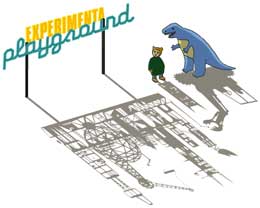 I was at the The Arts Centre in Melbourne recently to install an artwork in Experimenta Playground: International Biennial of Media Arts. Exhibitions of this scale that focus predominantly on media arts are relatively rare in Australia, so in addition to the excitement of having a work in the show, the chance to see some very cool works from around the world, was a bit of a treat.
I was at the The Arts Centre in Melbourne recently to install an artwork in Experimenta Playground: International Biennial of Media Arts. Exhibitions of this scale that focus predominantly on media arts are relatively rare in Australia, so in addition to the excitement of having a work in the show, the chance to see some very cool works from around the world, was a bit of a treat.
The Arts Centre is in Melbourne’s city centre, adjacent to Federation Square, overlooking the Yarra River promenade on Southbank. Experimenta has made the most of this amazing location by allowing Shu-Lea Cheang’s well-known work Baby Love (2005), to spill out onto the promenade itself. Baby Love is an installation of giant mobile teacups that you can get in and drive around, taking a huge soft-plastic, dummy sucking baby as your passenger. The teacups move at a pace that is considerably slower than amusement park dodgem cars, but the Babies croon love songs downloaded from the internet, so this additional feature provides a delightfully weird experience where nostalgia and future dreaming collide.
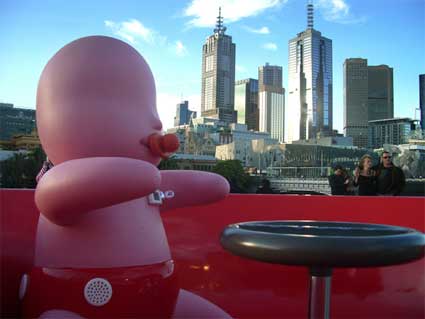 Shu Lea CHEANG, Baby Love (2005). Photo by Gavin Sade.
Shu Lea CHEANG, Baby Love (2005). Photo by Gavin Sade.
There are quite a few great video works in the exhibition including another time splice video by Daniel Crooks, On Perspective and Motion – Part II (2006) where film played in forward and reverse is spliced together to create distortions of time and space. The distortions created by the time splice technique makes these videos beautifully compelling. Everyday environments take on an eerie, otherworldly feel as people glide by on blurred feet that look like slithering tentacles, walking towards their own image then disappearing when their future and past selves meet.
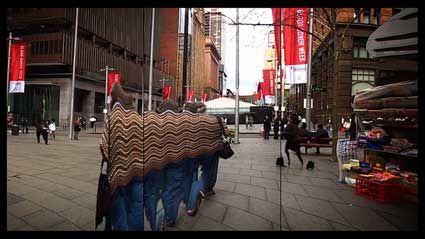
Daniel Crooks, On Perspective and Motion – Part II (2006). Courtesy of Experimenta and the artist.
I also really loved Sawatohwasi’s (Hiraki Sawa & Tomoyuki Washio) video Unseen Park (2006), because my first impression was the sense that it illustrated the little pieces of magic and wonder that can be found (even in the most ordinary places), if one chooses to look in a certain way. Filmed from an ultra-low perspective where the camera is literally on the ground, the video features animations of wondrous tiny mythical creatures (combinations of human legs, origami puppies, elephant heads, and the like) ambling in a variety of walking styles each unique to the hybrid creature, across deserted backgrounds such as a carnival fairgrounds, train tracks, and playgrounds. These hand drawn two-dimensional animations are truly charming, and I later learned from the exhibition catalogue, that Sawa and Washia “collaborat[ed] with children from Taipei to create an apprehension of the world from a child’s point of viewâ€?. Whilst they have definitely achieved that aim, to me this work also felt like a small slice of how creative people see the world.
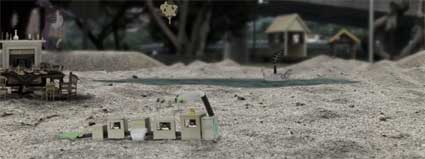 Sawatohwasi, Unseen Park (2006). Courtesy of Experimenta and the artist
Sawatohwasi, Unseen Park (2006). Courtesy of Experimenta and the artist
Guillaume Reymond’s video Game Over Project: Pong, Space Invaders and Pole Position (2005 – 7) appealed to the child in me who grew up on a healthy diet of Atari Space Invaders and Galaga. Set in a theatre featuring rows of raked seating, human “pixels� move up and down, side to side, in patterns reminiscent of a game of human Tetris. The video is actually documentation of a 6-hour performance where the cast actually moved from seat to seat, whilst over 400 photographs were taken to create this stop motion video. Seeing the work for the first time, it seemed this work must have been done digitally, so this insight into Reymond’s technique makes the work even richer and more captivating.
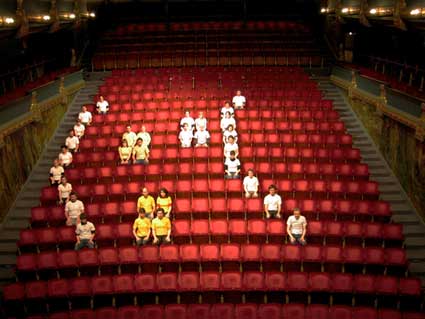 Guillaume Reymond, Game Over Project (2005 – 7). Courtesy of Experimenta and the artist
Guillaume Reymond, Game Over Project (2005 – 7). Courtesy of Experimenta and the artist
From an interactive perspective, one of the stand-out works in the show is Philip Worthington’s Shadow Monsters (2005). In an age where (apart from gaming) computing is largely at the service of commerce and the military, it is refreshing to see hot programming serving the noble purpose of helping people to be silly in public places. This work uses video tracking to create animations of monster eyes, teeth, horns, scales, beaks and burps which emerge out of shadow’s cast by people playing in the installation space. The work is as fun to watch as it is to play, and over the few days I visited the exhibition I noticed this space was continually filled with both children and adults making monsters and urging each other on.
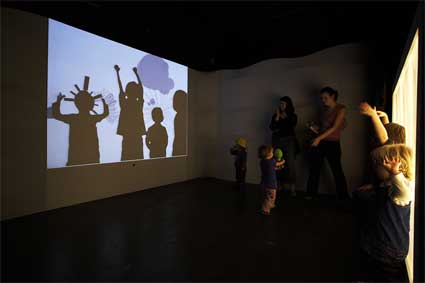 Philip Worthington, Shadow Monsters (2005). Courtesy of Experimenta. Photo by Andrew Lloyd.
Philip Worthington, Shadow Monsters (2005). Courtesy of Experimenta. Photo by Andrew Lloyd.
The artwork I helped to make and install was Charmed (2007), a collaborative work with Gavin Sade and Matt Dwyer. This work offers access to a hand-drawn animated world through touch sensitive screens encased in glowing resin pods. Users can move the pods to navigate through this world, and touch the screens to disrupt the lives of it’s inhabitants who are otherwise mesmerised by routine daily tasks and the spell of television. Repeated tapping or rapid movement can cause chaos in the world ranging from car-crashes and earthquakes to very personal effects on individual inhabitants, such as making a man drink so much that he wets his pants.
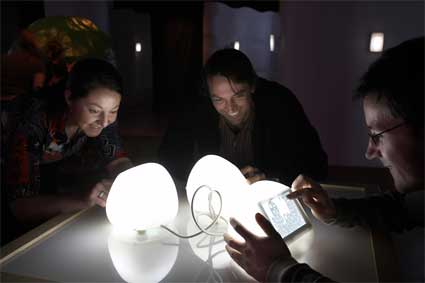 Bracks, Sade & Dwyer, Charmed (2007). Courtesy of Experimenta. Photo by Andrew Lloyd.
Bracks, Sade & Dwyer, Charmed (2007). Courtesy of Experimenta. Photo by Andrew Lloyd.
This work was an Experimenta New Visions Commission, made especially for this touring exhibition. Experimenta has commissioned three Australian works for this Biennial, and because of the complexity of the projects, these works are very often collaborations.
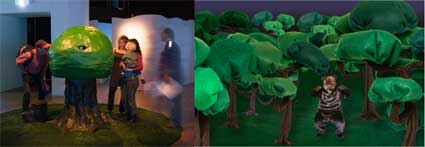
Lawrey & Middleton, What’s Yours Is Mine (2007). Left: Photo by Priscilla Bracks. Right: Image courtesy of the artists.
Also commissioned this year were What’s Yours is Mine (2007) by David Lawrey and Jaki Middleton.David Lawrey and Jaki Middleton’s installation “What’s Yours is Mine” is a homage to Bruce Nauman‘s nihilisic, anti art performance video No, No, New Museum (Clown Torture series 1987). In this work, instead of a dressing as a angry knave, stamping his foot, shouting no, no, no, one of the artists is dressed as a bear. The video image is contained within a fibro-glass sculpture of a tree. There are 4 holes in the tree’s leaves that offer a view into the bear’s world. Video of the bear appears as a holographic image in the centre of the tree, thanks to a clever use of the magical Pepper’s Ghost technique (projecting an image onto glass set at a 45 degree angle to create the impression that the 3 dimensional hologram is moving in the space behind the glass). Sensors detect people at each peep hole, so the bear turns to face people as they approach his tree, and shouts at them, no, no, no. The tree itself looks like the Apple Tree House toys popular in the mid-1980’s and just as that toy was to children, this work offers a portal into an illusory world – in the bear’s forest, which is his place alone to enjoy. The bear’s angry attempts to keep people out of his forest of felt trees growing out of fake astro-turf grass, seems almost pathetic. He is a hologram and has none of the great might commonly associated with his species. So whilst this work whisked me back to childhood, it also brought me to something urgent and confronting, in the real world. The bear has no power against those with suitable means, who view anything not owned by people (ie wild nature) as resources available exploitation. What’s theirs is ours.
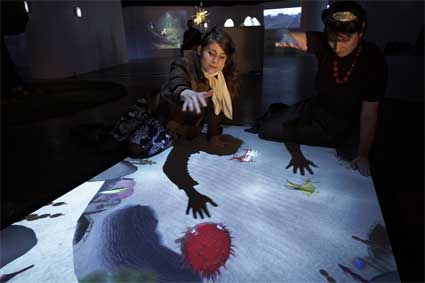 Barnett, Buchanan, Ballingall, MacKellar & Rubino, Immersion (2007). Courtesy of Experimenta. Photo by Andrew Lloyd.
Barnett, Buchanan, Ballingall, MacKellar & Rubino, Immersion (2007). Courtesy of Experimenta. Photo by Andrew Lloyd.
Immersion (2007) by Angela Barnett, Andrew Buchanan, Darren Ballingall, Chris MacKellar and Christian Rubino is a real time interactive 3D experience, that takes us through 3 different levels of ocean ecologies. Creatures encountered in these environments, respond to shadows. Blue electric eels, spark with lightning bolts, jelly fish glow, and fish scatter. Images are projected onto the floor, creating the impression, this world is being revealed through a glass bottomed boat.
Related: Review of Experimenta Vanishing Point.
After the Melbourne premiere closes on Sunday 23 September, the exhibition will embark on an Australian national tour to galleries in cities and regional centres including Sydney, Perth, Adelaide and Bendigo throughout 2008 and 2009.
Click and scroll down to see the dates of the upcoming Experimenta exhibitions in Australia.
